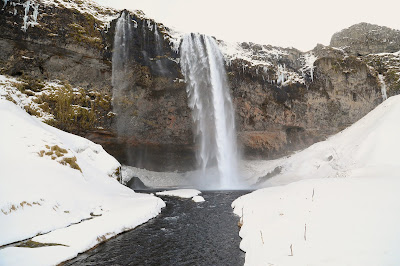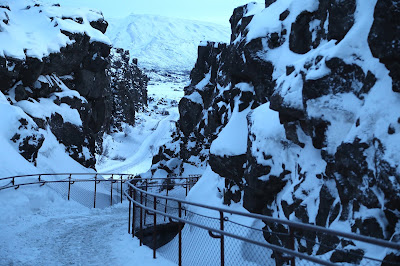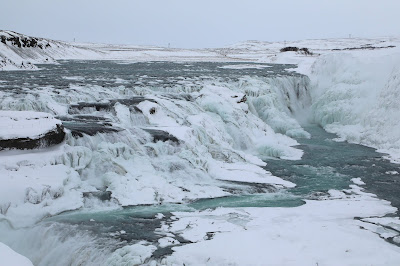Let’s Go South!!
It looked like we might get a break in the weather so loaded up and headed South, searching for waterfalls and hoping to make it to Vik.
It looked like we might get a break in the weather so loaded up and headed South, searching for waterfalls and hoping to make it to Vik.
Bobby Fisher Grave - Bobby Fischer died on 17th January 2008 at the age of 64 of kidney failure. He was laid to rest late at night under a vail of secrecy at Laugardælir cemetery, a few hundred metres away from the Bobby Fischer centre. There is a small beautiful chapel there and his grave is easily located. This is located in town of Selfoss.
Iceland tip, generally speaking, if it ends in “foss” it is a waterfall.
A bit further down Rt 1 we came to Urriðafoss. Urriðafoss is a waterfall in Þjórsá River. Þjórsá is Iceland's longest river, 230 km, and Urriðafoss is the most voluminous waterfall in the country. This mighty river drops down (360 m/sec) by the edge of Þjórsárhraun lava field in beautiful and serene surroundings. Þjórsárhraun lava field is the result of the greatest lava flow on earth since the Ice Age. The mist from the waterfall caused the trail to be very very very icy. We did watch a person fall (not hurting themselves) and began to try and swim along the trail, rather humorous.
We made a gas station stop for a hot dog lunch and restroom break before continuing South.
The weather to the South is starting to look menacing.
Soon we get to Seljalandsfoss. We again find a very icy parking lot and trails. If one is driving on your own, there are stations where you pay for parking. I tried three and was unable to make the machines work.
Seljalandsfoss waterfall is fed by melting water from the famed glacier-capped Eyjafjallajokull volcano. In the summer time you can walk behind this waterfall, however in winter the trail is closed due to icefall. Further to the west one finds several smaller falls. It is very impressive.
The skies are getting darker in the direction we want to travel, yet the next foss is only a few kilometers away. To the North in this area we find Eyjafjallajökull, the volcano with the name that no one outside Iceland can pronounce.
Eyjafjallajokull is one of the smaller ice caps of Iceland. The volcano has erupted relatively frequently since the last glacial period, most recently on March 20, 2010. Then in April of 2010 is when a large ash plume caused the travel problems in Europe.
Eyjafjallajokull consists of a volcano which is completely covered by an ice cap. The ice cap covers an area of about 100 square kilometres (39 sq mi) and it has many outlet glaciers. The main outlet glaciers are to the north: Gigjokull that flows into Lonid, and Steinholtsjokull which flows into Steinholtslon. The mountain itself stands 1,651 metres (5,417 ft) at its highest point. It has a crater 3–4 kilometres (1.9–2.5 mi) in diameter that opens to the North.
Soon we arrived at Skogafoss and there seems to be a short break in the weather. QUICK!!! Get the camera ready as the sunshine combined with mist from the waterfall we might get a RAINBOW, AND WE DID!
We park the car and get to walk through soft snow to the foss. According to legend, a Viking named Thrasi hid his hoarded gold under the falls. The legend says a young man almost succeeded in recovering the gold. He tied a rope to the chest handle ring and pulled. He only retrieved the ring and returned with it. The ring was later used for the church door at Skogar.
The skies continued to darken and the winds were blowing harder. We decided to start our return to Reykjavik.
We did make a stop at the Bobby Fischer Center and it was really interesting.
This centre houses memorabilia of the 11th World Chess Champion BOBBY FISCHER and the Selfoss Chess Club. The American Bobby Fischer became the World Chess Champion when he defeated the Soviet grandmaster and reigning World Champion Boris Spassky in Reykjavík in the summer of 1972. The match is generally referred to as the Match of the Century. It took place at the height of the Cold War, mirroring the tense relations between the two superpowers, the United States of America and the Soviet Union. Since 1948 Soviet chess players had held the World Championship title - uninterrupted for 25 years. On display at the Bobby Fischer centre in Selfoss are, among other things, Spassky´s and Fischer´s scoresheets, a printout from the radiation measurements demanded by Spassky´s delegation after the 17th game and a replica of the chess board used during the match, which was staged in Laugardalshöll in Reykjavík. In addition there are many curious items related to Bobby Fischer's stay in Iceland during his last years (2005-2008), for example his chair from the antiquarian bookshop Bókin in Reykjavík.
The roads got a tad greasy from the blowing snow, and it was not fun driving over the pass into Reykjavik. We made it and headed to the pool at Laugardalshöll, Yes, this is the complex where the chess match was held. Fun to learn this after going to the pool all these years.
We had a hot dog before our swim and then one after.
Back at the apartment we packed up and prepared for the trip home.
Thinking our next trip might be a ring road camping trip, when the weather is a bit better.


















































